City contours Cologne
For those with a head for heights and a heart for fun
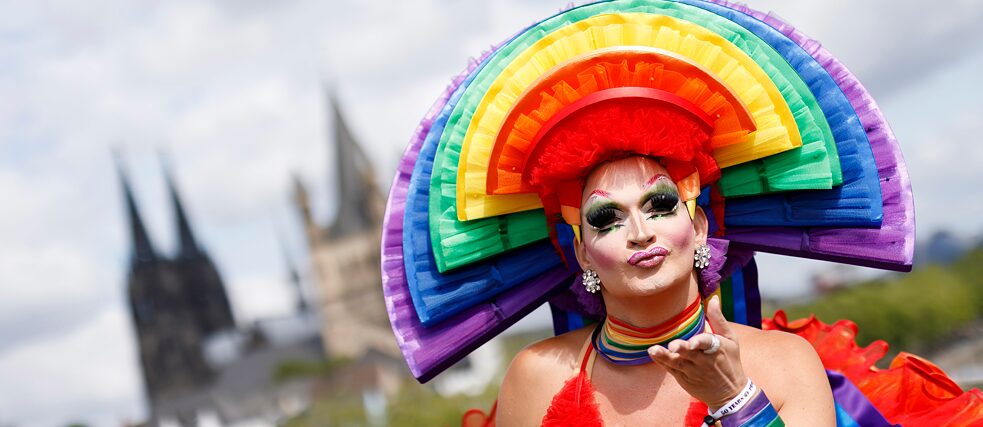
More to offer than the cathedral and the Carnival – Cologne is also a stronghold of gay and lesbian life: participant of the Christopher Street Day festival 2019. | Photo (detail): © picture alliance/Christoph Hardt/Geisler-Fotopress
The first things most people think of when they hear Cologne are the cathedral and Carnival. But this city on the Rhine, founded by the Romans and already a commercial hub in the Middle Ages, has so much more to offer. Visitors can admire the remains of an ancient temple outside a McDonald’s toilet, enjoy culture in a former cable factory, and attend the largest computer game trade fair in the world.
By Christian Bos
Cologne Cathedral and its secrets
 There is simply no getting around it: you cannot visit Cologne without seeing the cathedral.
| Photo (detail): © Adobe
There is simply no getting around it: you cannot visit Cologne without seeing the cathedral. This is all some tourists see of the city, which is really too bad. What would be even worse though would be to see the cathedral without really seeing it. This gothic house of God is filled with secrets and surprises. You probably didn’t know that the cathedral was almost completely white when it was completed in 1880, pretty late given that construction began in 1248, and not black as it is today. Were the façade to be cleaned – which will never happen because it would entail an amazing amount of work and involve covering the edifice in scaffolding for a number of years – you could also see grey stone quarried from Drachenfeld (a mountain in Königswinter near Bonn) and brown sandstone. The cathedral’s uniform darker shade is accumulated dirt and soot. And you would probably never guess that a small statue of Pope Frances graces the upper, right-hand corner of the main entrance in the western façade. French queen Maria de Medici’s intestines were buried under a slab of red marble in the floor of the ambulatory in the Chapel of the Three Kings. A person could easily spend years inside the cathedral and without discovering even half of its secrets. On a sunny, early afternoon, visitors can bathe in the colourful pools of light that stream in through the 11,500 glass squares Gerhard Richter shaped into the stained-glass window in the south transept inaugurated in 2007. If you start planning early enough, be sure to register for tour of the cathedral’s roof, though you have to be at 16 years old and have a head for heights.
There is simply no getting around it: you cannot visit Cologne without seeing the cathedral.
| Photo (detail): © Adobe
There is simply no getting around it: you cannot visit Cologne without seeing the cathedral. This is all some tourists see of the city, which is really too bad. What would be even worse though would be to see the cathedral without really seeing it. This gothic house of God is filled with secrets and surprises. You probably didn’t know that the cathedral was almost completely white when it was completed in 1880, pretty late given that construction began in 1248, and not black as it is today. Were the façade to be cleaned – which will never happen because it would entail an amazing amount of work and involve covering the edifice in scaffolding for a number of years – you could also see grey stone quarried from Drachenfeld (a mountain in Königswinter near Bonn) and brown sandstone. The cathedral’s uniform darker shade is accumulated dirt and soot. And you would probably never guess that a small statue of Pope Frances graces the upper, right-hand corner of the main entrance in the western façade. French queen Maria de Medici’s intestines were buried under a slab of red marble in the floor of the ambulatory in the Chapel of the Three Kings. A person could easily spend years inside the cathedral and without discovering even half of its secrets. On a sunny, early afternoon, visitors can bathe in the colourful pools of light that stream in through the 11,500 glass squares Gerhard Richter shaped into the stained-glass window in the south transept inaugurated in 2007. If you start planning early enough, be sure to register for tour of the cathedral’s roof, though you have to be at 16 years old and have a head for heights.
Solid self-esteem and “Kölsch” rock
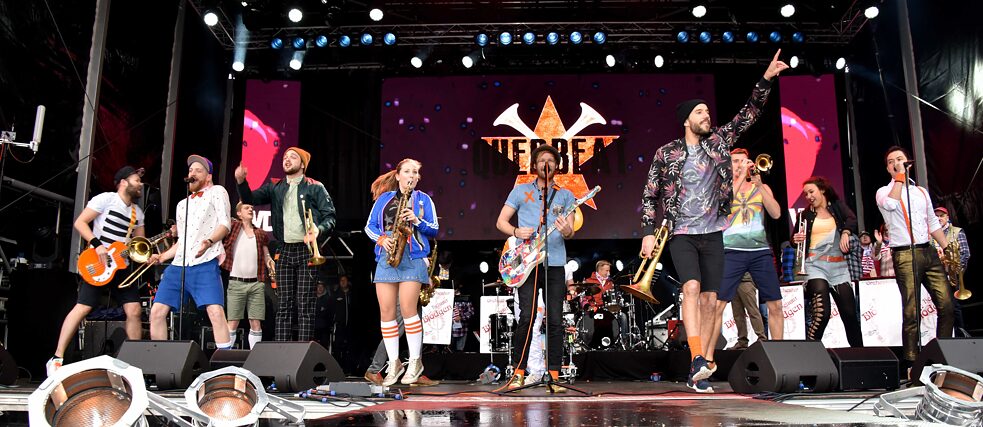 Many bands who sing in the Kölsch dialect have enjoyed national success, like the 13-piece brass-pop Querbeat band on tour here.
| Photo (detail): © picture alliance/Horst Galuschka/dpa
The beautifully curved four-metre-high letters above the four-lane Nord-Süd-Fahrt, one of Cologne main streets right next to the never-ending and ongoing restoration of Cologne’ stages on Offenbach Square, encourage drivers to “love your city”. For 15 years now, artist Merlin Bauer has used this motto in his fight to increase appreciation and conservation of the city’s post-war architecture many find ugly. Born in Graz, Bauer probably never imagined his slogan would find such complete acceptance. The people of Cologne do not need much encouragement to love their city. A song by the same name was released ages ago by Cat Ballou with a guest appearance by local football hero Lukas Podoski. The band is just one of dozens of successful groups who have made “Kölsch” music one of the city’s best exports. It all began in the 1970s with Bläck Fööss, who combined British beat music and Irish folklore with at times satirical, at times sentimental observations from a Rhinelander’s perspective. If the Fööss are considered Old Testament, the Höhnern were the first to propel this Kölsch-dialect music into the rowdy, self-indulgent and slightly drunken state still shaping the genre today. This might be down to the fact that “Kölsch” not only refers to the local way of talking, but also to a top-fermented beer brewed inside the city limits. Be that as it may, bands like Brings, Kasalla and Querbeat (who are actually from neighbouring Bonn) have enjoyed national success and not just during Carnival. Perhaps this is because the laisser-faire Kölsch attitude feeds a desire for a more southern, laid-back approach to life in the more staid parts of Germany. In Cologne, corruption is charmingly referred to as “Klüngel”, the German word for “clique”, and the collective shoulder shrug about one’s own shortcomings has been written into the “Cologne Constitution”, a primer into the Cologne way of life. It includes such Kölsch wisdoms as “Et hätt noch immer mit jot jejange” (it has always worked out) and “Wat wellste maache?” (what do you want to do?). As appealing as this is, it can also make loving the city a bit of a chore at times.
Many bands who sing in the Kölsch dialect have enjoyed national success, like the 13-piece brass-pop Querbeat band on tour here.
| Photo (detail): © picture alliance/Horst Galuschka/dpa
The beautifully curved four-metre-high letters above the four-lane Nord-Süd-Fahrt, one of Cologne main streets right next to the never-ending and ongoing restoration of Cologne’ stages on Offenbach Square, encourage drivers to “love your city”. For 15 years now, artist Merlin Bauer has used this motto in his fight to increase appreciation and conservation of the city’s post-war architecture many find ugly. Born in Graz, Bauer probably never imagined his slogan would find such complete acceptance. The people of Cologne do not need much encouragement to love their city. A song by the same name was released ages ago by Cat Ballou with a guest appearance by local football hero Lukas Podoski. The band is just one of dozens of successful groups who have made “Kölsch” music one of the city’s best exports. It all began in the 1970s with Bläck Fööss, who combined British beat music and Irish folklore with at times satirical, at times sentimental observations from a Rhinelander’s perspective. If the Fööss are considered Old Testament, the Höhnern were the first to propel this Kölsch-dialect music into the rowdy, self-indulgent and slightly drunken state still shaping the genre today. This might be down to the fact that “Kölsch” not only refers to the local way of talking, but also to a top-fermented beer brewed inside the city limits. Be that as it may, bands like Brings, Kasalla and Querbeat (who are actually from neighbouring Bonn) have enjoyed national success and not just during Carnival. Perhaps this is because the laisser-faire Kölsch attitude feeds a desire for a more southern, laid-back approach to life in the more staid parts of Germany. In Cologne, corruption is charmingly referred to as “Klüngel”, the German word for “clique”, and the collective shoulder shrug about one’s own shortcomings has been written into the “Cologne Constitution”, a primer into the Cologne way of life. It includes such Kölsch wisdoms as “Et hätt noch immer mit jot jejange” (it has always worked out) and “Wat wellste maache?” (what do you want to do?). As appealing as this is, it can also make loving the city a bit of a chore at times.
The most exciting museums… and the most relaxing
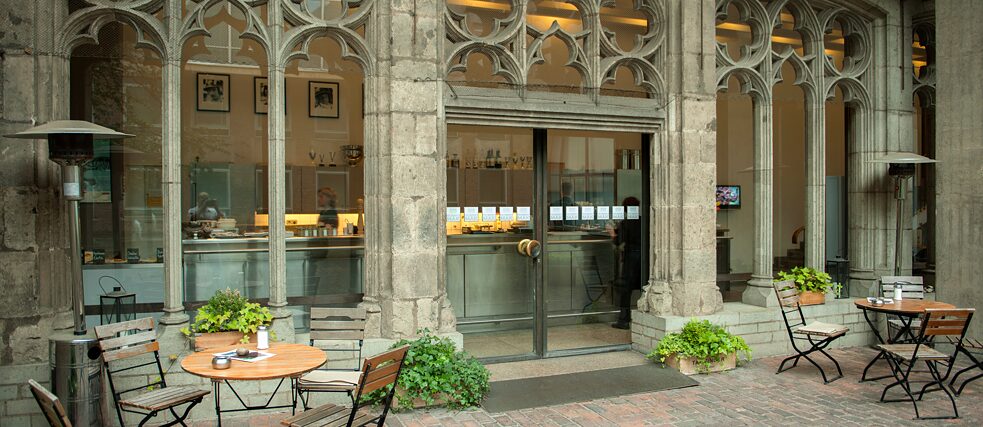 The café in the Museum for the Applied Arts is one of the loveliest and quietest spots amidst the hustle and bustle of the city.
| Photo (detail): © picture alliance/Hackenberg-Photo-Koeln/Rainer Hackenberg
On its website, the city of Cologne claims to finance more museums from its own coffers than any other city in Germany. Many more institutes with private operators swell the ranks of the nine public museums. From the Käthe Kollwitz Museum, the world’s largest collection of works by the artist of the same name who was known for her compassionate lithographs depicting hunger and suffering, somewhat ironically located in the uppermost floor of a shopping centre, to the Fragrance Museum in the Farina Haus, the oldest perfume factory in the world still in existence and the birthplace of the famous Eau de Cologne. The Wallraf Richartz Museum is right across the street and a flagship in Cologne’s museum landscape. The picture gallery exhibits works by masters of the Middle Ages up to the 20th century. Museum Ludwig takes up where it leaves off, offering a collection of truly impressive contemporary pieces from Expressionism and Pop Art. Outside of Paris, you’d be hard pressed to find a larger collection of Picassos from all periods. But the less prominent museums are also the most magical spots in Cologne’s range of museums. The chronic lack of funding is palpable in the Museum of Applied Arts, MAKK for short, but the café with its inner courtyard is a beautiful and quiet oasis in the midst of the urban hustle and bustle. Just a short walk away is the Kolumba, the Art Museum of the Archbishopric of Cologne, impressive for the building alone. Opened in 2007, Swiss star architect Peter Zumthor built it on top of the ground plan of the Church of St Columbia destroyed in the Second World War and the ruins of are on display in the museum. Visitors looking for a bit of quiet in Cologne will enjoy a sojourn in the mahogany-panelled library.
The café in the Museum for the Applied Arts is one of the loveliest and quietest spots amidst the hustle and bustle of the city.
| Photo (detail): © picture alliance/Hackenberg-Photo-Koeln/Rainer Hackenberg
On its website, the city of Cologne claims to finance more museums from its own coffers than any other city in Germany. Many more institutes with private operators swell the ranks of the nine public museums. From the Käthe Kollwitz Museum, the world’s largest collection of works by the artist of the same name who was known for her compassionate lithographs depicting hunger and suffering, somewhat ironically located in the uppermost floor of a shopping centre, to the Fragrance Museum in the Farina Haus, the oldest perfume factory in the world still in existence and the birthplace of the famous Eau de Cologne. The Wallraf Richartz Museum is right across the street and a flagship in Cologne’s museum landscape. The picture gallery exhibits works by masters of the Middle Ages up to the 20th century. Museum Ludwig takes up where it leaves off, offering a collection of truly impressive contemporary pieces from Expressionism and Pop Art. Outside of Paris, you’d be hard pressed to find a larger collection of Picassos from all periods. But the less prominent museums are also the most magical spots in Cologne’s range of museums. The chronic lack of funding is palpable in the Museum of Applied Arts, MAKK for short, but the café with its inner courtyard is a beautiful and quiet oasis in the midst of the urban hustle and bustle. Just a short walk away is the Kolumba, the Art Museum of the Archbishopric of Cologne, impressive for the building alone. Opened in 2007, Swiss star architect Peter Zumthor built it on top of the ground plan of the Church of St Columbia destroyed in the Second World War and the ruins of are on display in the museum. Visitors looking for a bit of quiet in Cologne will enjoy a sojourn in the mahogany-panelled library.
From PopKomm to Gamescom
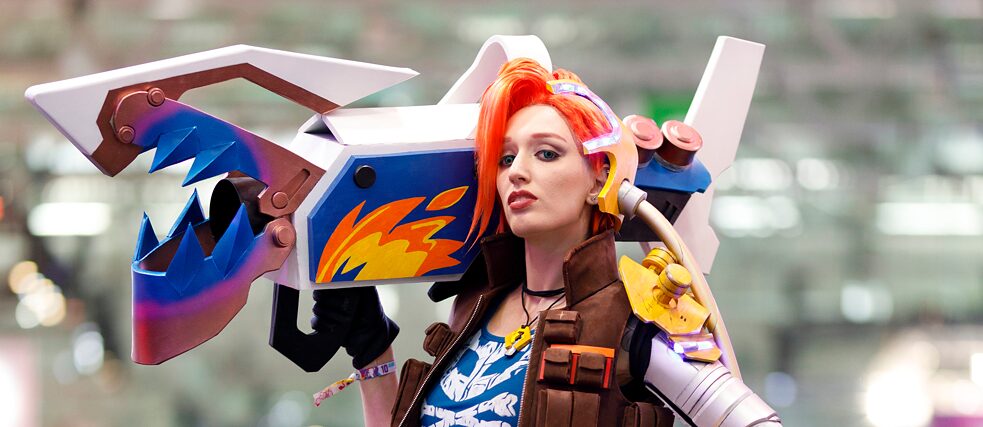 Even outside of Carnival, residents of Cologne will use any excuse to don a costume – such as cosplay at the world’s leading gamer trade fair, gamescom.
| Photo (detail): © picture alliance/Geisler-Fotopress/Christoph Hardt
In the 1990s, the heyday of the music industry, Cologne called itself – with quintessential overconfidence – the pop music capital. The city hosted PopKomm, one of the world’s leading music and entertainment trade fairs, a huge open-air festival on the Cologne Ring featuring hundreds of concerts. And even through the music industry was already in free fall due to the internet and download and streaming services, Cologne felt rejected and hurt when the PopKomm left for Berlin at the start of the new century. The wound has long since healed and for ten years now, the world’s largest computer and video game trade fair gamescom has been drawing masses to Cologne at the end of August. The most recent gamescom attracted almost 400,000 visitors, many in cosplay costumes. The ever increasing number of visitors has led the fair to expand across the entire city.
Even outside of Carnival, residents of Cologne will use any excuse to don a costume – such as cosplay at the world’s leading gamer trade fair, gamescom.
| Photo (detail): © picture alliance/Geisler-Fotopress/Christoph Hardt
In the 1990s, the heyday of the music industry, Cologne called itself – with quintessential overconfidence – the pop music capital. The city hosted PopKomm, one of the world’s leading music and entertainment trade fairs, a huge open-air festival on the Cologne Ring featuring hundreds of concerts. And even through the music industry was already in free fall due to the internet and download and streaming services, Cologne felt rejected and hurt when the PopKomm left for Berlin at the start of the new century. The wound has long since healed and for ten years now, the world’s largest computer and video game trade fair gamescom has been drawing masses to Cologne at the end of August. The most recent gamescom attracted almost 400,000 visitors, many in cosplay costumes. The ever increasing number of visitors has led the fair to expand across the entire city.
How Mülheim built a bridge
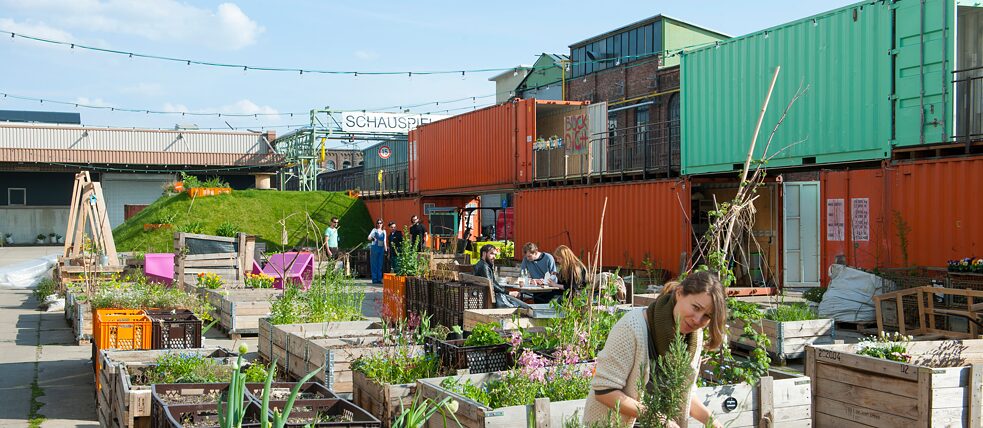 The Carlswerk factory building in Cologne-Mülheim used to crank out wires, areal cables and high-voltage wires. Today the compound is an alternate venue for the Kölner Schauspielhaus theatre troupe. The “Carlsgarten” community garden is right in front of the venue.
| Photo (detail): © picture alliance/Hackenberg-Photo-Koeln/Rainer Hackenberg
Mülheim fought incorporation for a long time. This formerly independent town on the right bank of the Rhine River became part of Cologne in 1914, against the will of its residents. As consolation for losing their independence, the Mülheimer Bridge was slated for construction. The supporting cables were made in the Carlswerk, a cable factory in Mülheim where transatlantic cables had once been produced. For years, left-bank Cologne residents only made their way to the right bank to see a concert in the E-Werk or the Palladium across the way. A number of television studios rented space here from the Harald Schmidt Show to Stefan Raab’s diverse TV formats. Visitor flow did not really increase though until the Schauspielhaus Köln (Cologne Theatre) moved its temporary quarters into the Carlswerk in 2013. At the time, no one could have anticipated that renovating the theatre and opera on Offenbach Square in the centre of the city would devolve into a disastrous, never-ending project like the Berlin-Brandenburg Airport. It had one positive side-effect: the Carlswerk and surrounding area have developed into a wonderfully popular cultural landscape with three theatres, two concert halls, and a huge climbing hall. The range of eateries is impressive too, though a little side trip to one of the many restaurants in neighbouring Keupstraße, Cologne’s Little Turkey, is well worth it.
The Carlswerk factory building in Cologne-Mülheim used to crank out wires, areal cables and high-voltage wires. Today the compound is an alternate venue for the Kölner Schauspielhaus theatre troupe. The “Carlsgarten” community garden is right in front of the venue.
| Photo (detail): © picture alliance/Hackenberg-Photo-Koeln/Rainer Hackenberg
Mülheim fought incorporation for a long time. This formerly independent town on the right bank of the Rhine River became part of Cologne in 1914, against the will of its residents. As consolation for losing their independence, the Mülheimer Bridge was slated for construction. The supporting cables were made in the Carlswerk, a cable factory in Mülheim where transatlantic cables had once been produced. For years, left-bank Cologne residents only made their way to the right bank to see a concert in the E-Werk or the Palladium across the way. A number of television studios rented space here from the Harald Schmidt Show to Stefan Raab’s diverse TV formats. Visitor flow did not really increase though until the Schauspielhaus Köln (Cologne Theatre) moved its temporary quarters into the Carlswerk in 2013. At the time, no one could have anticipated that renovating the theatre and opera on Offenbach Square in the centre of the city would devolve into a disastrous, never-ending project like the Berlin-Brandenburg Airport. It had one positive side-effect: the Carlswerk and surrounding area have developed into a wonderfully popular cultural landscape with three theatres, two concert halls, and a huge climbing hall. The range of eateries is impressive too, though a little side trip to one of the many restaurants in neighbouring Keupstraße, Cologne’s Little Turkey, is well worth it.
“Drink doch ene met” (Come on, drink one with us)
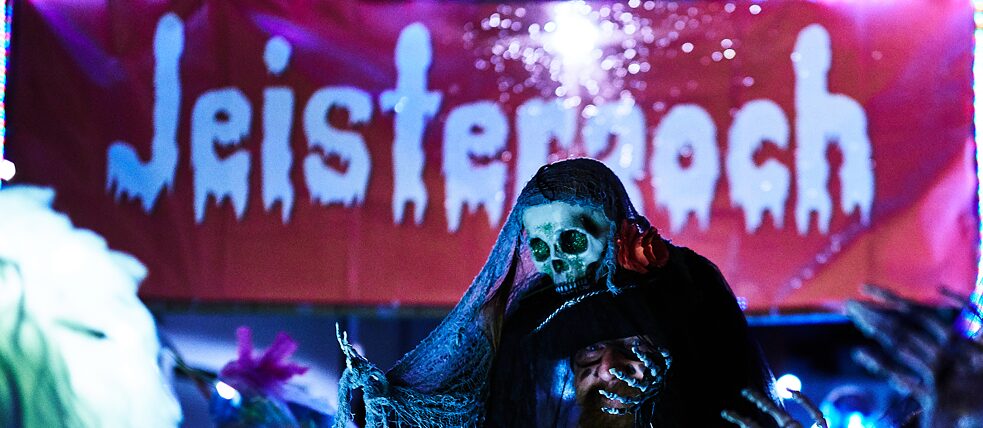 The “tolle Tage” (fun days) take place throughout Cologne – in the bars, on the streets, in the clubs and even in the streetcars.
| Photo (detail): © Geisterzug.de
Carnival is sacred to anyone from Cologne, and most would assert that Carnival here easily rivals the celebrations in Brazil. It may not always seem that way to outsiders through. People from outside the Rhineland region generally think the Rose Monday parade and the long-winded live broadcasts are the essence of Carnival in Cologne. Those from around Cologne think of the opening ceremony for the street festival on the Old Marketplace at exactly 11:11 o’clock on “Wieverfastelovend” (Crones’ Carnival), which some associate with excessive alcohol consumption. Both are to be avoided if possible, since the “tolle Tage” (fun days) take place all around Cologne: in the bars, who put their tables against the windows for the sole purpose of allowing celebrants to climb up on them and sway in unison, in the streets, in the clubs and even in the streetcars. Most take off time from work and many employers declare Rose Monday an unofficial holiday. Every resident of Cologne has their own, individual idea of where and how to celebrate. If you want to join the party, the best thing to do is seek contact to the natives, very easy in a city as open and friendly as Cologne. There is one non-negotiable however: you must come decked out in a lovingly hand-crafted costume.
The “tolle Tage” (fun days) take place throughout Cologne – in the bars, on the streets, in the clubs and even in the streetcars.
| Photo (detail): © Geisterzug.de
Carnival is sacred to anyone from Cologne, and most would assert that Carnival here easily rivals the celebrations in Brazil. It may not always seem that way to outsiders through. People from outside the Rhineland region generally think the Rose Monday parade and the long-winded live broadcasts are the essence of Carnival in Cologne. Those from around Cologne think of the opening ceremony for the street festival on the Old Marketplace at exactly 11:11 o’clock on “Wieverfastelovend” (Crones’ Carnival), which some associate with excessive alcohol consumption. Both are to be avoided if possible, since the “tolle Tage” (fun days) take place all around Cologne: in the bars, who put their tables against the windows for the sole purpose of allowing celebrants to climb up on them and sway in unison, in the streets, in the clubs and even in the streetcars. Most take off time from work and many employers declare Rose Monday an unofficial holiday. Every resident of Cologne has their own, individual idea of where and how to celebrate. If you want to join the party, the best thing to do is seek contact to the natives, very easy in a city as open and friendly as Cologne. There is one non-negotiable however: you must come decked out in a lovingly hand-crafted costume.
The wild Zülpicher and the quiet Rathenau
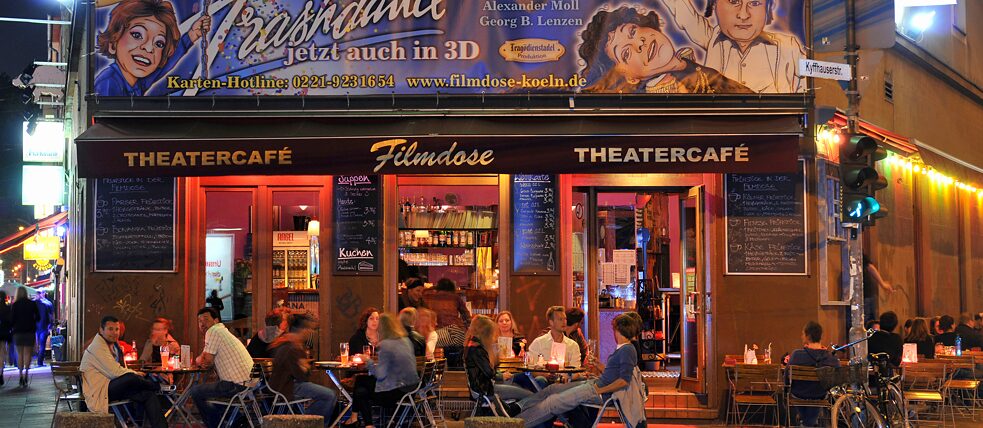 Few Cologne locals can say they have never spent a wild night or two on the “Zülp”. Along with bars, pubs and snack bars, the area offers culture at the “Filmdose” theatre café and arthouse cinema at “Off Broadway”.
| Photo (detail): © picture alliance/imageBROKER/Schoening
Zülpicher Straße at the heart of Kwartier Latäng – a play on the university Latin Quarter in Paris – links the city centre and the university. The Zülpicher is packed with snack bars and inexpensive pubs and clubs, and has always been the spot new arrivals to the city go to party. During the Carnival street parades, the party can get a bit out of hand here, sometimes resulting in unpleasant scenes. More mature students tend to avoid the Zülpicher at night, or go just to take in an arthouse film at the wonderful Off-Broadway cinema followed by delicious falafel two buildings over at Habibi, considered the best in Cologne. A few streets away from the Zülpicher, the atmosphere around Rathenau Square is more relaxed with its Italian, Spanish, Peruvian, Japanese, and Near-Eastern restaurants. During the summer months, a local citizen’s initiative runs a popular beer garden in the square. The little park hosts a mix of students, families (there is a playground) and boule players. On the east side of the square is Cologne Synagogue, a neo-Romantic building from the end of the 19th century. Cologne’s Jewish congregation is presumed to be the oldest north of the Alps. Be sure to eat at Mazal Tov, the kosher restaurant in the synagogue, a well-kept secret for which you will need a reservation.
Few Cologne locals can say they have never spent a wild night or two on the “Zülp”. Along with bars, pubs and snack bars, the area offers culture at the “Filmdose” theatre café and arthouse cinema at “Off Broadway”.
| Photo (detail): © picture alliance/imageBROKER/Schoening
Zülpicher Straße at the heart of Kwartier Latäng – a play on the university Latin Quarter in Paris – links the city centre and the university. The Zülpicher is packed with snack bars and inexpensive pubs and clubs, and has always been the spot new arrivals to the city go to party. During the Carnival street parades, the party can get a bit out of hand here, sometimes resulting in unpleasant scenes. More mature students tend to avoid the Zülpicher at night, or go just to take in an arthouse film at the wonderful Off-Broadway cinema followed by delicious falafel two buildings over at Habibi, considered the best in Cologne. A few streets away from the Zülpicher, the atmosphere around Rathenau Square is more relaxed with its Italian, Spanish, Peruvian, Japanese, and Near-Eastern restaurants. During the summer months, a local citizen’s initiative runs a popular beer garden in the square. The little park hosts a mix of students, families (there is a playground) and boule players. On the east side of the square is Cologne Synagogue, a neo-Romantic building from the end of the 19th century. Cologne’s Jewish congregation is presumed to be the oldest north of the Alps. Be sure to eat at Mazal Tov, the kosher restaurant in the synagogue, a well-kept secret for which you will need a reservation.
Roman ruins in McDonald’s
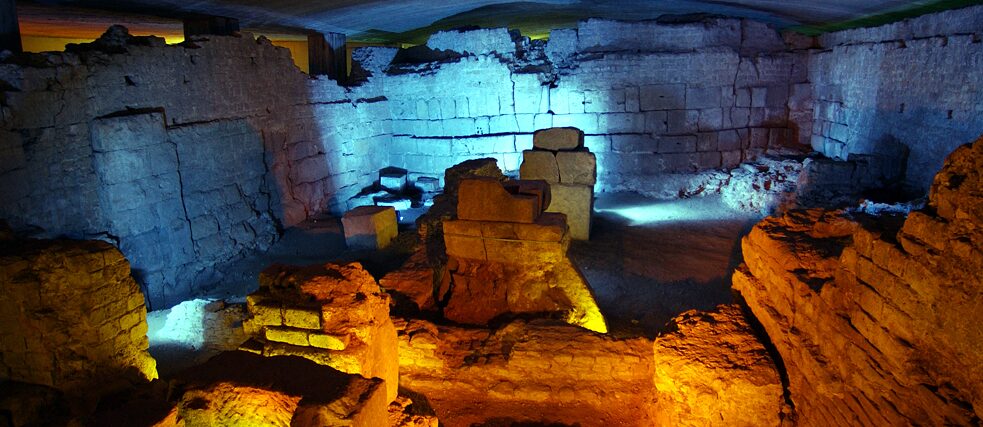 You can find traces of the ancient Romans on almost every corner in Cologne – like the archaeological excavation of the Praetorium shown here.
| Photo (detail): © picture-alliance/dpa/Horst Ossinger
Cologne can trace its roots back to the Romans. The city was founded in around 50 B. C. during the reign of Caesar Claudius as “Colonia Claudia Ara Agrippinensium”, which roughly translates as “Claudius’ Colony and Sacrificial Altar of the Agrippinians”. The Romano-Germanic Museum features artefacts from this time period, though it is currently undergoing renovations and no re-opening date has been set. The same applies to the second most important place to view the remains of Roman Cologne. The Praetorium underneath the town hall is the ruins of the Proconsul of the Province of Lower Germania’s palace. But the former centre of Colonia Claudia Ara Agrippinensium is open to the public, free of charge and more than a little unusual. Here, where the two main arteries of the colony intersected, was Roman Cologne’s large forum. Today two popular shopping avenues, Hohe Straße and Schildergasse, retrace the routes these ancient arteries. More evidence of Cologne’s Roman glory days is on display in the bottom level of clothing retailer C&A. An escalator from the pedestrian zone takes visitors directly down into an in-store McDonald’s. Right outside the toilets, tucked up underneath the escalator, a block of “Opus caementicium”, Roman concrete that was once part of the foundation of the forum complex, is on display. Here where 2,000 years of tradition and a fast-food restaurant lavatory meet, a sign explains the forum’s history and architecture. Only in Cologne.
You can find traces of the ancient Romans on almost every corner in Cologne – like the archaeological excavation of the Praetorium shown here.
| Photo (detail): © picture-alliance/dpa/Horst Ossinger
Cologne can trace its roots back to the Romans. The city was founded in around 50 B. C. during the reign of Caesar Claudius as “Colonia Claudia Ara Agrippinensium”, which roughly translates as “Claudius’ Colony and Sacrificial Altar of the Agrippinians”. The Romano-Germanic Museum features artefacts from this time period, though it is currently undergoing renovations and no re-opening date has been set. The same applies to the second most important place to view the remains of Roman Cologne. The Praetorium underneath the town hall is the ruins of the Proconsul of the Province of Lower Germania’s palace. But the former centre of Colonia Claudia Ara Agrippinensium is open to the public, free of charge and more than a little unusual. Here, where the two main arteries of the colony intersected, was Roman Cologne’s large forum. Today two popular shopping avenues, Hohe Straße and Schildergasse, retrace the routes these ancient arteries. More evidence of Cologne’s Roman glory days is on display in the bottom level of clothing retailer C&A. An escalator from the pedestrian zone takes visitors directly down into an in-store McDonald’s. Right outside the toilets, tucked up underneath the escalator, a block of “Opus caementicium”, Roman concrete that was once part of the foundation of the forum complex, is on display. Here where 2,000 years of tradition and a fast-food restaurant lavatory meet, a sign explains the forum’s history and architecture. Only in Cologne.
Youthful Ehrenfeld
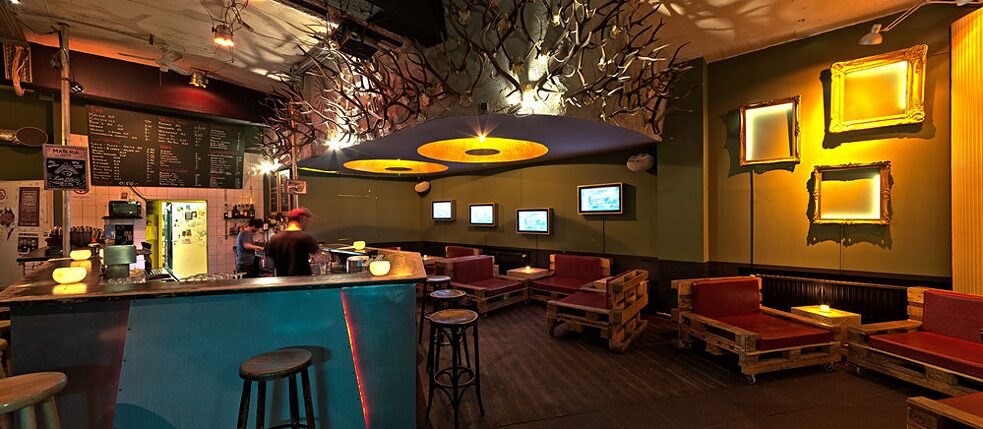 The Artheater has been around since Ehrenfeld set out on a path to becoming a subculture hotspot. It offers a unique mix of café, a sophisticated party and concert programme, and bold experimental theatre.
| Photo (detail): © Matthias Porath / Lilville / artheater.de
Old Cologne is surprisingly young. More than 10,000 new residents between the ages of 18 and 30 moved to the city in 2019 alone. Nowhere is this young, vibrant Cologne better represented than in Ehrenfeld, formerly a blue-collar area. Still represented, at any rate, since, like everywhere else, gentrification is shaping the future of Cologne and its “Veedels”, the Kölsch word for quarters. It has already taken out some institutions of the city’s nightlife, like the Underground and most recently the Heinz Gaul techno club. There are still plenty of entertainment venues left with the quality ranging from dive to top shelf. There is no need to get all dolled up to enjoy a fun evening out. The Artheater has been around since Ehrenfeld set out on a path to becoming a subculture hotspot. This unusual mix of café, sophisticated party programme (generally electronic danc music), experimental theatre and a carefully cultivated concert line-up opened its doors in 1998. Just a few steps away, Bumann & Sohn created an inviting venue for dancing and drinking in an old workshop in 2017. The interior is entirely homemade and a bit on the rough side. The beer garden’s industrial-romantic flair is attractive in the summer, and carefully selected bands and artists grace the small stage here year round, many of whom soon go on to fill larger arenas. Across the way, Club Bahnhof Ehrenfeld stretches beneath the three arches of the commuter train station that gave it its name. The CBE specialises in black music of all kinds from jazz to hip hop, from soul to salsa. Some rap stars got their start here and a few legendary musicians have made guest appearances under the rails.
The Artheater has been around since Ehrenfeld set out on a path to becoming a subculture hotspot. It offers a unique mix of café, a sophisticated party and concert programme, and bold experimental theatre.
| Photo (detail): © Matthias Porath / Lilville / artheater.de
Old Cologne is surprisingly young. More than 10,000 new residents between the ages of 18 and 30 moved to the city in 2019 alone. Nowhere is this young, vibrant Cologne better represented than in Ehrenfeld, formerly a blue-collar area. Still represented, at any rate, since, like everywhere else, gentrification is shaping the future of Cologne and its “Veedels”, the Kölsch word for quarters. It has already taken out some institutions of the city’s nightlife, like the Underground and most recently the Heinz Gaul techno club. There are still plenty of entertainment venues left with the quality ranging from dive to top shelf. There is no need to get all dolled up to enjoy a fun evening out. The Artheater has been around since Ehrenfeld set out on a path to becoming a subculture hotspot. This unusual mix of café, sophisticated party programme (generally electronic danc music), experimental theatre and a carefully cultivated concert line-up opened its doors in 1998. Just a few steps away, Bumann & Sohn created an inviting venue for dancing and drinking in an old workshop in 2017. The interior is entirely homemade and a bit on the rough side. The beer garden’s industrial-romantic flair is attractive in the summer, and carefully selected bands and artists grace the small stage here year round, many of whom soon go on to fill larger arenas. Across the way, Club Bahnhof Ehrenfeld stretches beneath the three arches of the commuter train station that gave it its name. The CBE specialises in black music of all kinds from jazz to hip hop, from soul to salsa. Some rap stars got their start here and a few legendary musicians have made guest appearances under the rails.
A little Cologne fountain miracle
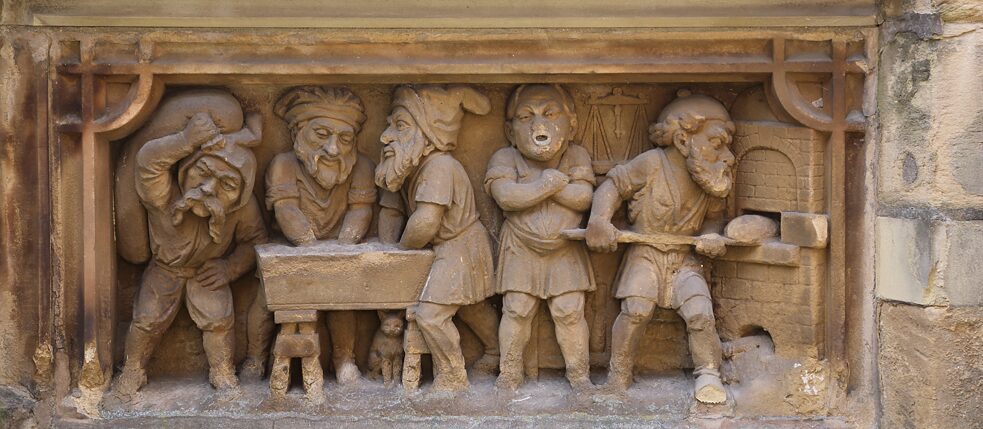 Heinzelmännchen chiselled into the bubbling Heinzelmännchenbrunnen.
| Photo (detail): © Adobe
The tales about “Heinzelmännchen”, the little people who finish up all the work not completed during the day at night until a human being catches them and they disappear forever, might be the origins of Cologne residents’ conviction that things will turn out alright if you don’t look too closely. The legend is literally set in stone at the famous Heinzelmännchenbrunne, a fountain quite conveniently located right in front of the oldest brewery in the city, the Früh am Dom. There are more, though much less attention generating, fountains nearby, like the small Taubenbrunnen (Pigeon Fountain) on the west side of the cathedral where the water swirls into a whirlpool at the centre. Artist Edward Mataré wanted to give “the cathedral pigeons a place to drink”. The fountain was inaugurated in 1953 to the strains of the song “La Paloma” while dignitaries passed a bottle of schnapps. You can wade right into the Rheingartenbrunnen, a water feature designed by British pop-art artist Eduardo Paolozzi, known for his cover for Paul McCartney’s Red Rose Speedway album. Children will enjoy hopping from ashlar to ashlar above the industrial-inspired bronze shapes emerging from the water. The Wasserkinetische Plastik, a kinetic water sculpture by Wolfgang Göddertz on Ebertplatz, rusted away for years. When the sunken square with the forlorn fountain and many dark corners earned a reputation as a criminal hot-spot and no-go area, the city and local residents got together to get the fountain bubbling again. Now you frequently see children wading through the cooling spray and Ebert Square has once again become a popular spot to meet between the Agnes Quarter and Eigelstein: a true fountain miracle even more fantastic than the Heinzelmännchen tales.
Heinzelmännchen chiselled into the bubbling Heinzelmännchenbrunnen.
| Photo (detail): © Adobe
The tales about “Heinzelmännchen”, the little people who finish up all the work not completed during the day at night until a human being catches them and they disappear forever, might be the origins of Cologne residents’ conviction that things will turn out alright if you don’t look too closely. The legend is literally set in stone at the famous Heinzelmännchenbrunne, a fountain quite conveniently located right in front of the oldest brewery in the city, the Früh am Dom. There are more, though much less attention generating, fountains nearby, like the small Taubenbrunnen (Pigeon Fountain) on the west side of the cathedral where the water swirls into a whirlpool at the centre. Artist Edward Mataré wanted to give “the cathedral pigeons a place to drink”. The fountain was inaugurated in 1953 to the strains of the song “La Paloma” while dignitaries passed a bottle of schnapps. You can wade right into the Rheingartenbrunnen, a water feature designed by British pop-art artist Eduardo Paolozzi, known for his cover for Paul McCartney’s Red Rose Speedway album. Children will enjoy hopping from ashlar to ashlar above the industrial-inspired bronze shapes emerging from the water. The Wasserkinetische Plastik, a kinetic water sculpture by Wolfgang Göddertz on Ebertplatz, rusted away for years. When the sunken square with the forlorn fountain and many dark corners earned a reputation as a criminal hot-spot and no-go area, the city and local residents got together to get the fountain bubbling again. Now you frequently see children wading through the cooling spray and Ebert Square has once again become a popular spot to meet between the Agnes Quarter and Eigelstein: a true fountain miracle even more fantastic than the Heinzelmännchen tales.
Comments
Comment